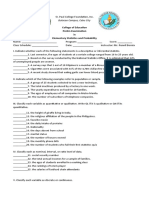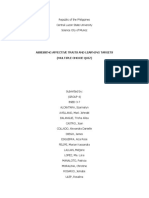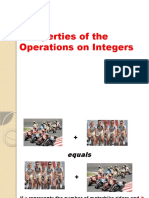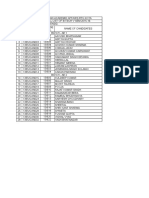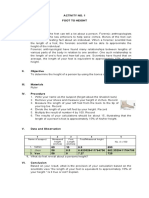Prelim Exam Answer Key
Prelim Exam Answer Key
Uploaded by
Mary Chiles MedinaCopyright:
Available Formats
Prelim Exam Answer Key
Prelim Exam Answer Key
Uploaded by
Mary Chiles MedinaOriginal Title
Copyright
Available Formats
Share this document
Did you find this document useful?
Is this content inappropriate?
Copyright:
Available Formats
Prelim Exam Answer Key
Prelim Exam Answer Key
Uploaded by
Mary Chiles MedinaCopyright:
Available Formats
University of Perpetual Help System Laguna
Isabela Campus
COLLEGE OF ARTS AND EDUCATION
Minante Uno, Cauayan City, Isabela 3305
BUSINESS STATISTICS
PRELIM EXAMINATION
2nd Semester, A.Y. 2020 – 2021
Name: Score:____________
Course: _____
I. MULTIPLE CHOICE
He discovered the equation for the normal distribution.
A. Abraham De Moivre
B. Adolph Quetelet
C. Sir Francis Galton
D. Laplace
ANSWER: A
What is the other name for bell shaped distribution?
A. Probability Distribution
B. Frequency Distribution
C. Gaussian Distribution
D. Multinomial Distribution
ANSWER: C
He made applications of statistics in the fields of psychology and education.
A. William S. Goset
B. Ronald Fisher
C. Francis Galton
D. Adolph Quetelet
ANSWER: D
He developed the theory of regression and correlation.
A. Ronal Fisher
B. Karl Pearson
C. Francis Galton
D. Adolph Quetelet
ANSWER: B
He developed the statistical test which used in inferential statistics. It is mainly used in the
analysis of variance.
A. Ronal Fisher
B. Karl Pearson
C. Francis Galton
D. Adolph Quetelet
ANSWER: A
Elementary Statistics and Probability Page 1 of 7
There are basically two types of statistics – descriptive and inferential. Which of the following
sentences are true about descriptive statistics?
A. Descriptive statistics enable you to make decisions about your data, for example, is one group
mean significantly different from the population mean?
B. Descriptive statistics describe the data.
C. Descriptive statistics enable you to draw inferences about your data, for example does one
variable predict another variable?
D. All of the above.
ANSWER: B
Which one of the following variables is not categorical?
A. Age of a person.
B. Gender of a person: male or female.
C. Choice on a test item: true or false.
D. Marital status of a person (single, married, divorced, other)
ANSWER: A
The variables whose measurement is done in terms such as weight, height, and length are
classified as:
A. Continuous variables
B. Measuring Variables
C. Flowchart variables
D. Discrete variables
ANSWER: A
The scale which categorize the events in collectively exhaustive manner and mutually exclusive
manner is classified as:
A. Discrete Scale
B. Continuous Scale
C. Valid Scale
D. Nominal Scale
ANSWER: D
The type of variable which can take fixed integer values is classified as:
A. flowchart variable
B. discrete variable
C. continuous variable
D. measuring Variables
ANSWER: B
The type of questions included in questionnaire to record responses in which the respondent can
answer in any way are classified as________.
A. multiple choices
B. itemized question
C. open ended questions
D. close ended questions
NASWER: C
The numerical or descriptive measure which is associated with variable to describe entire
Elementary Statistics and Probability Page 2 of 7
population of statistical phenomenon is classified as _______.
A. mixer
B. sample
C. parameter
D. process
ANSWER: C
The collection of all the elements such as group of variables for research is classified as:
A. statistical process
B. marginal error
C. data
D. population
ANSWER: D
She/he declared October of each year as National Statistics Month (NSM) in the Philippines.
A. Cory C. Aquino
B. Hernando Riquel
C. Miguel de Loarca
D. Gloria Macapagal Arroyo
ANSWER: A
What is the sample size of 2000 total number of respondents with margin of error of 5%?
A. 322
B. 323
C. 324
D. 325
ANSWER: A
What is the margin of error when the computed sample size of 1500 respondents is 1376?
A. 0.05
B. 0.01
C. 0.005
D. 0.025
ANSWER: B
A principal watching a teacher give a lesson to her class in order to judge her effectiveness as an
educator. What methods of collecting data applied by the principal?
A. Indirect Method
B. Direct Method
C. Naturalistic Observation
D. Participant Observation
ANSWER: C
Questions are formulated during the interview based on what the interviewee observes or hears
during the conversation. What method is applied to this?
A. Direct Method
B. Indirect Method
C. Structured Interview
D. Unstructured Interview
Elementary Statistics and Probability Page 3 of 7
ANSWER: D
It refers to continuous, permanent, compulsory recording of the occurrence of vital events
together with certain identifying or descriptive characteristics concerning them, as provided
through the civil code, laws or regulations of each country.
A. Experimental method
B. Registration Method
C. Indirect Method
D. Direct Method
ANSWER: B
A university student working on a project and wants to understand the average consumption of
soda on campus on a Friday night will most possibly call his/her classmates and friends and ask
how many cans of soda they consume. Or may go to a party nearby and conduct an easy survey.
There is always a chance that the randomly selected population may not accurately represent the
population of interest, thus increasing the chances of bias. What is the appropriate sampling
techniques to be used in this situation?
A. Stratified random Sampling
B. Purposive Sampling
C. Incidental Sampling
D. Convenience Sampling
ANSWER: D
The data collected from a survey, an observation or an experiment is simply known as _______.
A. Data set
B. Information
C. Raw Data
D. Consent
ANSWER: C
A simple random sample is one in which:
A. From a random starting point, every nth unit from the sampling frame is selected
B. A non-probability strategy is used, making the results difficult to generalize.
C. The researcher has a certain quota of respondents to fill for various social groups.
D. Every unit of the population has an equal chance of being selected
ANSWER: D
It is helpful to use a multi-stage cluster sample when:
A. The population is widely dispersed geographically
B. You have limited time and money available for travelling.
C. You want to use a probability sample in order to generalise the results
D. All of the above.
ANSWER: D
Which of the following is not a characteristic of quota sampling?
A. The researcher chooses who to approach and so might bias the sample.
B. Those who are available to be surveyed in public places are unlikely to constitute a
representative sample.
C. The random selection of units makes it possible to calculate the standard error.
Elementary Statistics and Probability Page 4 of 7
D. It is a relatively fast and cheap way of finding out about public opinions
ANSWER: C
The findings from a study of young single mothers at a university can be generalised to the
population of:
A. All young single mothers at that university
B. All young single mothers in that society
C. All single mothers in all universities
D. All young women in that university
II. TRUE or FALSE
Parameter is an attribute of a population.
A. TRUE
B. FALSE
ANSWER: A
A sample is the complete set of all possible observation of elements.
A. TRUE
B. FALSE
ANSWER: B
Predictor Variable is a variable that makes the outcome or result vary or differ.
A. TRUE
B. FALSE
ANSWER: A
The lowest level of measurement is the nominal.
A. TRUE
B. FALSE
ANSWER: A
Variate is a general value of a variable.
A. TRUE
B. FALSE
ANSWER: B
Random Sampling is the most common technique where it is done by simply writing the names
or numbers of all the members.
A. TRUE
B. FALSE
ANSWER: B
The researcher used indirect method wherein he/she observes the behavior of persons or
organizations.
A. TRUE
B. FALSE
ANSWER: B
Elementary Statistics and Probability Page 5 of 7
The researcher used quasi - experimental method to test the effectiveness of using SPSS in
Statistics class.
A. TRUE
B. FALSE
ANSWER: A
The researcher used indirect method for his research entitled, “Tertiary Education Subsidy: socio
– economic Implications to Perpetualite Students.”
A. TRUE
B. FALSE
ANSWER: A
Registration method is a gathering information enforced by certain laws.
A. TRUE
B. FALSE
ANSWER: A
II. Problem Solving. Answer the following items as instructed.
A. Write each of the following in full, that is, without summation signs. (2pts each)
6
1.
∑ Xi
i=1
2. 6
∑ (X ¿¿ i+1)¿
i=1
3. ∑ (3 X i )
i=1
4. 2
∑ (X ¿ ¿4 i Y i)¿
i=1
5. ∑ (Y ¿¿ i)¿
i=1
B. Evaluate the following summations. (2pts each)
4
1. ∑ k2
k =1
Elementary Statistics and Probability Page 6 of 7
6
2. ∑3k
k =2
21
3. ∑5
k=13
5
4. ∑ (2 k −4 )
k =3
3 2
5. (∑
k=1
( 3 k −1 ) )
C. Consider the scores of 30 students in the qualifying examination for Philippine
Statistics quiz.
46 31 74 68 42 54 14 61 83 48
37 26 8 64 57 93 72 53 59 38
16 88 75 56 46 66 45 61 54 27
a. Construct the frequency distribution for the data:
a. Class Interval (9pts)
b. Tally and frequency (9pts)
c. columns containing percentages of relative frequency (4pts)
d. less than cumulative frequency and greater than cumulative frequency. (6pts)
Note: Wrong input of data every cell less 1 point from the total points.
b. Construct the following graphs using the data above: (3pts each)
a. Frequency Polygon
b. Histogram
c. Less than Ogive and Greater than ogive
d. Pie/Circle Graph
III. ESSAY (5pts)
How significant Statistics in your field of specialization?
GOD BLESS!
Prepared by: Approved by:
MANUEL C. FRANCISCO, LPT BRO. GLENN A. GALINGANA, FSM, LPT
Instructor Dean, College of Arts & Education
Elementary Statistics and Probability Page 7 of 7
Elementary Statistics and Probability Page 8 of 7
You might also like
- The Orthodox Keynesian SchoolDocument22 pagesThe Orthodox Keynesian Schoolasjad67% (3)
- Module 3Document11 pagesModule 3Jodelyn Quirao AlmarioNo ratings yet
- Symap A2 Eventbuilder EDocument54 pagesSymap A2 Eventbuilder EAlfredo Jiménez100% (3)
- Obtl in MATH EED 2Document11 pagesObtl in MATH EED 2SOFIA GUTIERREZNo ratings yet
- Overview Fusion Welding Standards PDFDocument1 pageOverview Fusion Welding Standards PDFHà Việt Đức100% (1)
- Teaching in The Specialized Field (Module 4)Document6 pagesTeaching in The Specialized Field (Module 4)Maria Angelica DeniaNo ratings yet
- Number and Number Sense Prelim Lesson 2Document44 pagesNumber and Number Sense Prelim Lesson 2hufana.dishelleanneNo ratings yet
- Lesson 4 Principles and Strategies in Teaching MathematicsDocument7 pagesLesson 4 Principles and Strategies in Teaching MathematicsJeorge HugnoNo ratings yet
- Principles and Stategies in Teaching MathDocument35 pagesPrinciples and Stategies in Teaching MathGeraldine RamosNo ratings yet
- Course Guide - Teaching Mathematics in The Primary GradesDocument5 pagesCourse Guide - Teaching Mathematics in The Primary GradesReonel GalayNo ratings yet
- Lesson 5 Principles and Strategies in Teaching MathematicsDocument7 pagesLesson 5 Principles and Strategies in Teaching MathematicsJeorge HugnoNo ratings yet
- College of Education Prelim Examination in Elementary Statistics and ProbabilityDocument2 pagesCollege of Education Prelim Examination in Elementary Statistics and ProbabilityNel Bornia60% (5)
- MODULE 1 Teaching Math in The Primary GradesDocument19 pagesMODULE 1 Teaching Math in The Primary GradesAYALA CARACTERNo ratings yet
- TEACHING IN THE SPECIALIZED FIELD (Module 2)Document4 pagesTEACHING IN THE SPECIALIZED FIELD (Module 2)Maria Angelica DeniaNo ratings yet
- Types of Curr OrganizationDocument4 pagesTypes of Curr OrganizationZara jane MaralitNo ratings yet
- Module 1 - Review of Basic ConceptsDocument15 pagesModule 1 - Review of Basic ConceptsMarvin Yebes ArceNo ratings yet
- Maed Curriculum EnhancementDocument9 pagesMaed Curriculum Enhancementapi-292024713No ratings yet
- MM16 Handout 1Document7 pagesMM16 Handout 1glenville genanibanNo ratings yet
- Round-Robin: TournamentsDocument13 pagesRound-Robin: TournamentsAbhilash KNo ratings yet
- Come Together: Measures of Central Tendency For Grouped DataDocument1 pageCome Together: Measures of Central Tendency For Grouped DataJerson MadronaNo ratings yet
- Math-I Secondary Education Curriculum 2010Document34 pagesMath-I Secondary Education Curriculum 2010Hari Ng SablayNo ratings yet
- Prelim Exam - College AlgebraDocument1 pagePrelim Exam - College AlgebraArbaya AlonganNo ratings yet
- Assessment and Evaluation in MathematicsDocument95 pagesAssessment and Evaluation in MathematicsMarnieNo ratings yet
- K-12 Mathematics CurriculumDocument12 pagesK-12 Mathematics CurriculumSharmaine Deblois CincoNo ratings yet
- Modern Geometry: Power Point PresentationDocument20 pagesModern Geometry: Power Point PresentationLara Mae Delos SantosNo ratings yet
- Limits Involving Trigonometric FunctionsDocument26 pagesLimits Involving Trigonometric FunctionsJewel EspirituNo ratings yet
- Principles of Teaching Sem Ed 2017-2018Document6 pagesPrinciples of Teaching Sem Ed 2017-2018Romelo MuldezNo ratings yet
- Chapter TestDocument22 pagesChapter TestSheila Mae AsuelaNo ratings yet
- Lesson 6 Principles and Strategies in Teaching MathematicsDocument5 pagesLesson 6 Principles and Strategies in Teaching MathematicsJeorge HugnoNo ratings yet
- Module 3-Problem Solving LESSON 1: Inductive and Deductive ReasoningDocument7 pagesModule 3-Problem Solving LESSON 1: Inductive and Deductive ReasoningWei Wu XianNo ratings yet
- UbD Research BaseDocument49 pagesUbD Research BaseAnalyn CasimiroNo ratings yet
- Module 5 The Fundamental Theorem of Calculus and Indefinite IntegralsDocument4 pagesModule 5 The Fundamental Theorem of Calculus and Indefinite IntegralsRodante P Hernandez Jr.No ratings yet
- Concept: Child and Adolescent Development/Facilitating LearningDocument360 pagesConcept: Child and Adolescent Development/Facilitating LearningJeffrey Roy Adlawan LopezNo ratings yet
- Baachelor of Secondary Education Major in MathDocument1 pageBaachelor of Secondary Education Major in MathDeckerChuaNo ratings yet
- Babylonian-Egyptian Ancient CivilizationDocument34 pagesBabylonian-Egyptian Ancient CivilizationRiza Mae BayoNo ratings yet
- Assessment, Measurement, and EvaluationDocument13 pagesAssessment, Measurement, and EvaluationMaria Priscillya PasaribuNo ratings yet
- Professional Education Final DrillsDocument220 pagesProfessional Education Final DrillsUser AdminNo ratings yet
- QUIZ - AffectiveDocument6 pagesQUIZ - AffectiveAnn Clarice0% (1)
- A Critique of Yashpal Committee ReportDocument3 pagesA Critique of Yashpal Committee Reportvencsv100% (1)
- Types of Lesson Plan Used in DepEdDocument2 pagesTypes of Lesson Plan Used in DepEdDacel NoquiraNo ratings yet
- Math Major's Thesis (Reviewed)Document57 pagesMath Major's Thesis (Reviewed)George Kevin TomasNo ratings yet
- LESSON 2, Mathematical Language, Symbols & SetsDocument59 pagesLESSON 2, Mathematical Language, Symbols & SetsnhichelcantosNo ratings yet
- Lesson 2 Mathematical Language and SymbolsDocument26 pagesLesson 2 Mathematical Language and SymbolslcNo ratings yet
- Instrumentation in MathDocument2 pagesInstrumentation in MathchadlowNo ratings yet
- Course Syllabus in Modern Geometry: Concepcion Holy Cross College College of Education DepartmentDocument7 pagesCourse Syllabus in Modern Geometry: Concepcion Holy Cross College College of Education DepartmentGrenica GamingNo ratings yet
- Assesment of Learning 2 SyllabusDocument8 pagesAssesment of Learning 2 SyllabuscheenNo ratings yet
- Principles and Strategies in Teaching Mathematics (Act 1)Document3 pagesPrinciples and Strategies in Teaching Mathematics (Act 1)Jan Mark Labrador100% (1)
- Mathematics in The Modern World-SyllabusDocument19 pagesMathematics in The Modern World-SyllabusJherolyn BuenavidezNo ratings yet
- Module 2 - Assessment and Evaluation in MathematicsDocument18 pagesModule 2 - Assessment and Evaluation in MathematicsMary May C. MantoNo ratings yet
- Teaching Mathematics in The Primary Grades FinalsDocument1 pageTeaching Mathematics in The Primary Grades FinalsRamer Garaes CardeñoNo ratings yet
- Math13 - Advanced Statistics Lecture Note: Case of Two Independent SamplesDocument27 pagesMath13 - Advanced Statistics Lecture Note: Case of Two Independent SamplesAbegail VillanuevaNo ratings yet
- StatDocument8 pagesStatAbegail TorremochaNo ratings yet
- Educ231 Final ExamDocument33 pagesEduc231 Final ExamOnemNo ratings yet
- Activity Worksheet MVDocument5 pagesActivity Worksheet MVabdulbasit salicNo ratings yet
- Elementary Stat Course Syllabus S.Y 2020-2021Document13 pagesElementary Stat Course Syllabus S.Y 2020-2021JENALYN CARDANONo ratings yet
- Properties - IntegersDocument15 pagesProperties - IntegersGhlends Alarcio GomezNo ratings yet
- Lecture Notes in GEd 102 Mathematics in The Modern WorldDocument49 pagesLecture Notes in GEd 102 Mathematics in The Modern WorldMae Del FraneNo ratings yet
- GE 103 - Syllabus - MATHEMATICS - IN - THE - MODERN - WORLDDocument5 pagesGE 103 - Syllabus - MATHEMATICS - IN - THE - MODERN - WORLDArgie ClaroNo ratings yet
- Module 1 Lesson 1 (With Answers)Document11 pagesModule 1 Lesson 1 (With Answers)LONo ratings yet
- Module I CONCEPTUAL FRAMEWORK OF MATHEMATICS EDUCATION COMPRA SUTCHEZA DAMAYO BSED3 ADocument43 pagesModule I CONCEPTUAL FRAMEWORK OF MATHEMATICS EDUCATION COMPRA SUTCHEZA DAMAYO BSED3 AMimme M. CompraNo ratings yet
- Office of The Dean For College of Agriculture: University of Science and Technology of Southern PhilippinesDocument4 pagesOffice of The Dean For College of Agriculture: University of Science and Technology of Southern PhilippinesJuneville Vincent AndoNo ratings yet
- Chapters 123Document41 pagesChapters 123Josenia ConstantinoNo ratings yet
- 2nd Quarter Stat and ProbDocument2 pages2nd Quarter Stat and Probeda mayNo ratings yet
- Matlab Assignment-2Document2 pagesMatlab Assignment-2ravindrachoudhary7008No ratings yet
- Ias 16 Ppe SDocument7 pagesIas 16 Ppe Sle8519191No ratings yet
- MW 54 Turbo Jet Engine InstructionsDocument39 pagesMW 54 Turbo Jet Engine InstructionsPREVISTONo ratings yet
- Vegan Products at SuperdrugDocument2 pagesVegan Products at SuperdrugVegan FutureNo ratings yet
- GraticuleDocument25 pagesGraticulebairamraddouiNo ratings yet
- Embedded Systems: Department of Electrical & Computer Engineering (College of Engineering) Wolaita Sodo UniversityDocument4 pagesEmbedded Systems: Department of Electrical & Computer Engineering (College of Engineering) Wolaita Sodo UniversityyishakNo ratings yet
- Cad 3d in IsraelDocument22 pagesCad 3d in IsraelMihai Madalin SuicaNo ratings yet
- "Jiggle" ExcerptDocument6 pages"Jiggle" ExcerptHere & NowNo ratings yet
- Atc 1 of 2019Document25 pagesAtc 1 of 2019sadiq arshadNo ratings yet
- Endocrine Surgery MCQDocument71 pagesEndocrine Surgery MCQShriyansh ChaharNo ratings yet
- Sudan EssayDocument1 pageSudan Essayapi-257610814No ratings yet
- Digital Tools For Managing DiabetesDocument1 pageDigital Tools For Managing DiabetesTaufiqurrokhman RofiiNo ratings yet
- Chapter Scheme & Synopsis GuidelinesDocument8 pagesChapter Scheme & Synopsis GuidelinesVishwa N100% (1)
- Store Design - 3 PDFDocument47 pagesStore Design - 3 PDFAdarsh Kumar RoyNo ratings yet
- Roll List of B.tech V Sem 2015-16Document26 pagesRoll List of B.tech V Sem 2015-16RohitGuptaNo ratings yet
- Complex Digital Signal Processing in TelecommunicationsDocument23 pagesComplex Digital Signal Processing in TelecommunicationssubuhpramonoNo ratings yet
- Spouses Roque Vs AguadoDocument3 pagesSpouses Roque Vs AguadoMary dela RosaNo ratings yet
- Listening Beyond The Echoes MediaDocument207 pagesListening Beyond The Echoes Mediab-b-b1230% (1)
- Design and Construction of A Structure For A Three Point Bending TestDocument13 pagesDesign and Construction of A Structure For A Three Point Bending TestIñigoNo ratings yet
- Piping Length RevDocument2 pagesPiping Length RevMing Ren TeyNo ratings yet
- Sep 2013+ansDocument16 pagesSep 2013+ansJohnWallNo ratings yet
- Latex Mathmode (PDFDrive)Document150 pagesLatex Mathmode (PDFDrive)Ingeniero riveraNo ratings yet
- ACTIVITY NO. 1 - Forensic Chemistry LabDocument2 pagesACTIVITY NO. 1 - Forensic Chemistry LabJenifer SadieNo ratings yet
- Python DemacusDocument414 pagesPython DemacussnehilNo ratings yet
- A 4Document13 pagesA 4arslan ashragNo ratings yet
- Econ 101 A Final PracticeDocument5 pagesEcon 101 A Final PracticeateiskaNo ratings yet
- ICAO SMS Senior Management Briefing - Dr. O. AliuDocument20 pagesICAO SMS Senior Management Briefing - Dr. O. Aliueljonny01No ratings yet











